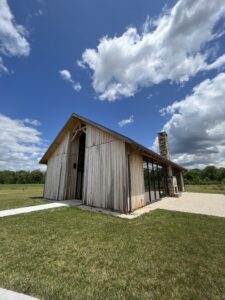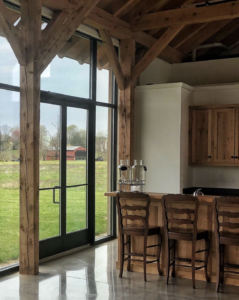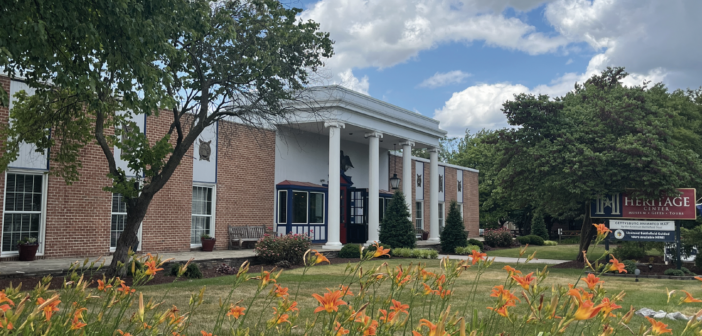Showcasing Heritage and Habitat
By Karen Hendricks
Stephanie Lightner wants visitors to experience the human side of history at The Gettysburg Heritage Center.
“It’s not so much about statistics or numbers. We focus on the human side of things, what life was like during the Civil War—people can relate to that,” says Stephanie, executive director of the landmark Steinwehr Avenue museum, gift shop and bookstore.
It’s quite a change from the museum’s early iteration—Gettysburg Wax Museum, founded in 1962, which featured life-size historical wax characters. Stephanie has been along for the ride ever since her high school days—when she began working there
28 years ago—through her college years as a history major at nearby Shippensburg University, to today.
“It’s been quite an experience to go from the wax museum to completely reinventing ourselves with a new story, being able to cater to what people are looking for today. People want to know, ‘How does history relate to me?’” she explains.
That’s why the museum’s “cellar experience” recreates what it was like for residents to live through the Battle of Gettysburg and why there’s a hollowed-out Witness Tree for visitors to not only see and touch—but climb through.
When the museum made the switch to interactive, hands-on history in 2017, it also switched from a for-profit to nonprofit structure under an umbrella organization, Gettysburg Nature Alliance. That move, Stephanie says, broadened the museum’s scope to encompass heritage and habitat,
in addition to history, in order to tell a bigger story about Gettysburg.
A Hub for Gettysburg
The museum’s interactive exhibits are designed to give visitors a broad overview of Gettysburg in a concise format that whets their appetite for additional information.
“We envision being a hub, a good starting point [for visitors],” says Stephanie. “We point you in different directions, like spokes of a wheel.”
For example, visitors can get the lay of the land from the museum’s 20-minute movie, Gettysburg: An Animated Map presented by the American Battlefield Trust. Licensed Battlefield Guides are on-site, offering tours directly from the museum. And if visitors want to know more about the civilian experience, Stephanie and the museum’s staff refer them to the Shriver House Museum.
Sometimes visitors want to explore Gettysburg and Adams County on their own, so the museum’s bookstore carries a wide variety of guidebooks.
“When you see people asking questions, asking for guidebooks of the battlefield, it makes me feel like there’s hope that history will stay alive, that we’re headed in the right direction, and the work we do here day in and day out is valuable and important,” Stephanie says. “Because to know where we came from and what we’ve done helps guide the future.”
It’s a message that ties into the umbrella organization’s mission.
“Heritage is everything that’s happened to you, up until this point, and you can’t enjoy the heritage without habitat being protected,” explains Dru Anne Neil, president of Gettysburg Nature Alliance. “It’s something different—nobody else has married those concepts, telling stories of both the heritage and habitat.”
Gettysburg’s heritage certainly encompasses its famous Civil War battle, but there are many additional layers of history, still evolving today, against the backdrop of Adams County’s natural environment.
“The battlefield is here for our generation, and we want to preserve it for future generations,” says Stephanie, a Gettysburg native whose own ancestors fought in the Civil War. “Here at the museum, we talk about the history of the battlefield and how the water was contaminated, the crops were destroyed. These things affected our society for a long time—it took Gettysburg a long time to rebound. We think it’s important for people to understand that under climate change now, we are facing similar situations with our water [as an important resource].”


Natural Treasures
Two additional locations—treasures of nature—are owned and operated by Gettysburg Nature Alliance.
First, the Learning Barn at Sachs Bridge, a $500,000 project funded by donations and completed over the past two years, is an educational venue built aside a Gettysburg icon—Sachs Covered Bridge—on land anonymously gifted to the nonprofit.
A state-of-the-art facility constructed with natural materials such as reclaimed timber and slate flooring, the barn is designed for small educational group use, such as the Gettysburg Foundation’s leadership programs. Additional partnerships are currently being explored for yoga sessions and birding.
The Learning Barn at Sachs Bridge, by its very location, shares the vital role of water in our lives.
“Our amazing habitat with Marsh Creek is part of the Chesapeake Bay watershed. That speaks to how important that little creek is to the bigger global issue of water health,” says Dru.
A second natural resource is being developed along Steinwehr Avenue, just two blocks south of the Gettysburg Heritage Center. The former Hardee’s site, tucked between McDonald’s and KFC at 533 Steinwehr Ave., was anonymously donated to the nonprofit.
“We’re developing it as an acre of nature,” Dru says. “We’ll help people learn about native plants, put in a Monarch [butterfly]station and have a place to sit and rest along Steinwehr.”
The nonprofit is kicking off a fundraising campaign for the acre of nature this summer.
For Dru, her position with the Gettysburg Nature Alliance represents the fourth museum experience she’s helped develop within Gettysburg’s tourism industry over the past 20 years. She originally moved to Adams County for a position with the then-Friends of the National Parks at Gettysburg (now the Gettysburg Foundation), and she managed the conversion of its Rupp House into a museum and visitor center. She also worked on the foundation’s Gettysburg National Military Park Museum & Visitor Center, which opened in 2008, and the creation of the Seminary Ridge Museum & Education Center, which opened its doors in 2013.
But her current role at Gettysburg Nature Alliance offers a first for Dru—
and for Gettysburg.
“Among the major historical attractions in town, our staff leadership team is 100% female,” says Dru. “You don’t normally see that in historical attractions, and we’re really proud of that.”
Gettysburg Nature Alliance
Gettysburg Heritage Center
297 Steinwehr Ave., Gettysburg
Admission is $10 for those 13+; $8 for children ages 6-12; group rates are available with free admission for Gettysburg residents.




